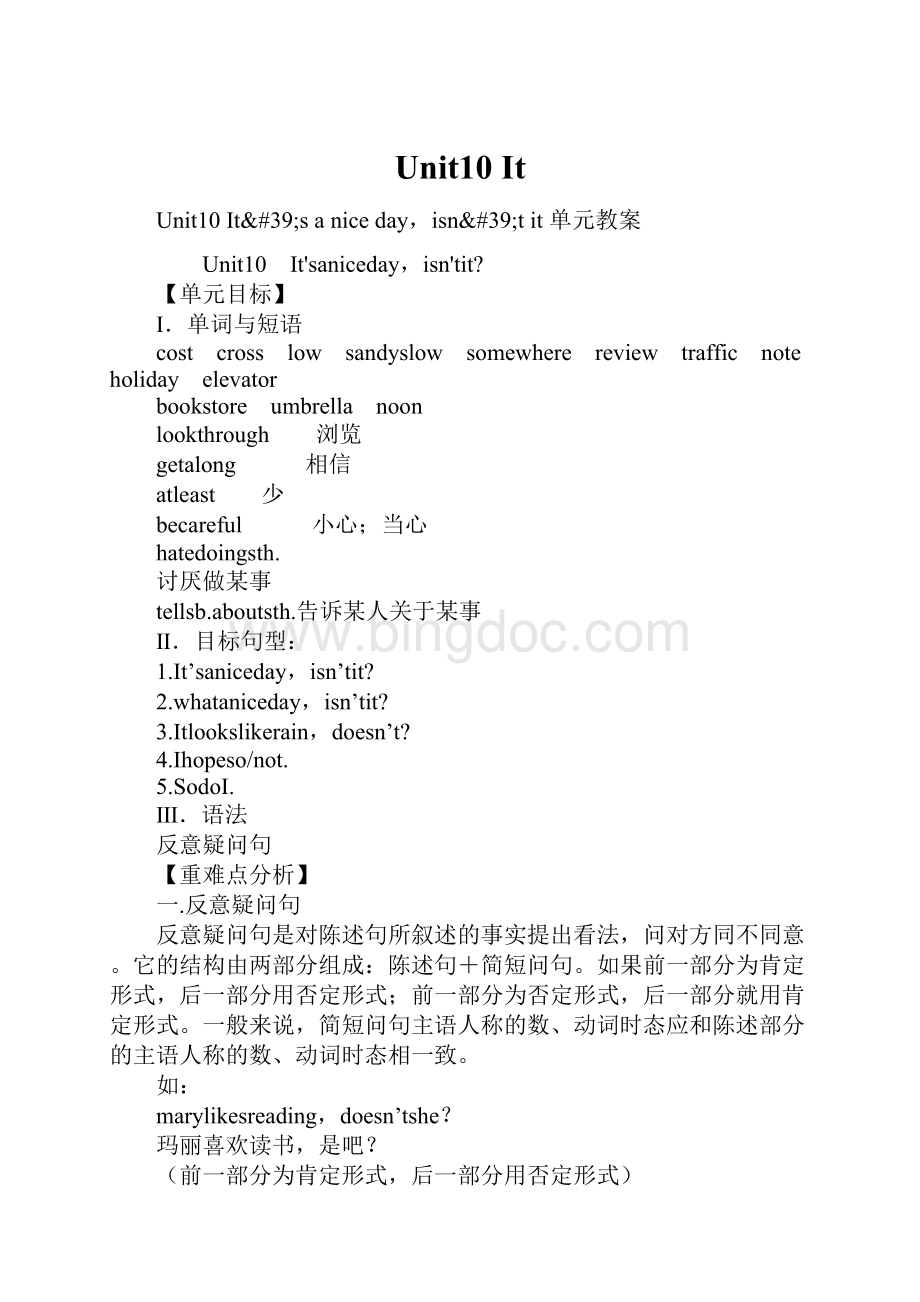Unit10 It.docx
《Unit10 It.docx》由会员分享,可在线阅读,更多相关《Unit10 It.docx(10页珍藏版)》请在冰点文库上搜索。

Unit10It
Unit10It'saniceday,isn'tit单元教案
Unit10 It'saniceday,isn'tit?
【单元目标】
Ⅰ.单词与短语
cost cross low sandyslow somewhere review traffic note holiday elevator
bookstore umbrella noon
lookthrough 浏览
getalong 相信
atleast 少
becareful 小心;当心
hatedoingsth.
讨厌做某事
tellsb.aboutsth.告诉某人关于某事
Ⅱ.目标句型:
1.It’saniceday,isn’tit?
2.whataniceday,isn’tit?
3.Itlookslikerain,doesn’t?
4.Ihopeso/not.
5.SodoI.
Ⅲ.语法
反意疑问句
【重难点分析】
一.反意疑问句
反意疑问句是对陈述句所叙述的事实提出看法,问对方同不同意。
它的结构由两部分组成:
陈述句+简短问句。
如果前一部分为肯定形式,后一部分用否定形式;前一部分为否定形式,后一部分就用肯定形式。
一般来说,简短问句主语人称的数、动词时态应和陈述部分的主语人称的数、动词时态相一致。
如:
marylikesreading,doesn’tshe?
玛丽喜欢读书,是吧?
(前一部分为肯定形式,后一部分用否定形式)
marydoesn’tlikereading,doesshe?
玛丽不喜欢读书,是吧?
(前一部分为否定形式,后一部分就用肯定形式)
you’reanewstudent,aren’tyou?
你是新来的学生,对吧?
(前一部分为肯定形式,后一部分用否定形式)
youaren’tanewstudent,areyou?
你不是新来的,对吧?
(前一部分为否定形式,后一部分就用肯定形式)
1.如果陈述句有一个助动词(包括can,must,need等情态动词),其简短问句用同一个助动词。
例如:
youhaven’tseenthatfilm,haveyou?
你没有看过那部电影,是吗?
Hecanswim,can’the?
他会游泳,对吗?
2.如果陈述部分包含no,never,hardly,few,little,scarcely等否定词,简短问句部分应用肯定形式。
例如:
youhavenotimeonmonday,haveyou?
星期一你没有时间,是吗?
HehasneverbeentoShanghai,hashe?
他从没去过上海,对吗?
Theycanhardlyimaginehowbeautifulsheis,canthey?
他们很难想象出她是多么漂亮,是吗?
3.陈述句部分是therebe句型时,简短问句部分也用therebe。
例如:
Therearesomepeopleintheroom,aren’tthere?
教室里有人,是吗?
4.在英语口语中,Iam后面的简短问句用aren'tI?
例如:
I’mlate,aren’tI?
我迟到了,是吗?
5.当陈述句部分含有否定词如nothing,nobody等不定代词时,简短问句部分应用肯定结构。
为避免重复,用代词it来代替nothing;用they或he来代替nobody。
例如:
Everythinggoeswell,doesn’tit?
一切顺利,是吗?
Everyoneishere,aren’tthey?
(注意:
此句问句与前句动词的数不一致。
)
6.祈使句后面的简短问句使用willyou?
won’tyou?
wouldyou?
canyou?
can’tyou?
wouldyou?
shallwe?
它们不是真正的疑问句(意为请),但常用升调。
won't用于邀请;will,would,can,can’t及shallwe用来告诉人们该做什么事,表请求。
例如:
Dositdown,won’tyou?
您请坐。
Givemeapen,willyou?
请给我一支笔。
openthedoor,wouldyou?
请打开门好吗?
Let’sgotogether,shallwe?
咱们一起走吧。
7.在Ithink,Ibelieve,Isuppose,Iguess等结构中,简短问句的主语往往与从句的主谓保持一致,
例如:
Ithinkshe’sout,isn’tshe?
我想她出去了,是吗?
Idon’tbelieveit’strue,isit?
我认为那不是真的,对吗?
注意:
在回答反意疑问句的问题时,如果回答是肯定的,要用yes,否定的要用no,在第一部分是否定形式时要特别注意,这时的英语回答与汉语回答是有区别的。
例如:
Thisisn’tyours,isit?
这不是你的,是吗?
yes,itis.
不,是我的。
No,itisn’t.
对,不是我的。
二.时间介词in,on,at
1.in
(1)表示在较长的时间里(如周/月份/季节/年份/世纪等)。
如:
inaweek;inmay;inspring/summer/autumn/winter;inXX;inthe1990’s等。
(2)表示在上午、下午或晚上。
如:
inthemorning/afternoon/evening。
(3)inthedaytime(在白天)属于固定搭配,指从日出到日落这一段时间,反义词组是inthenight。
(4)“in+一段时间”表示“多久以后/以内”,常与将来时连用。
如:
inhalfanhour;intenminutes;inafewdays等。
2.on后面所接的时间多与日期有关。
具体用法有:
(1)表示在具体的某一天(如日期、生日、节日或星期几)。
如:
onmay4th,1919;onmonday;onTeachers’Day;onmybirthday;onthatday等。
(2)表示某一天的上午、下午或晚上。
如:
onthemorningofjuly2;onSundayafternoon;onacoldwinterevening等。
3.at
具体用法有:
(1)表示在某一具体时刻,即几点几分。
如:
atsixo’clock;athalfpastnine;ataquartertosix;atthistime等。
(2)表示在某一短暂的时间。
如:
atnoon;atthismoment;attheendofayear;atthestartoftheconcert等。
(3)ItlastsfromjunetoAugust.
三.last v持续为延续性动词,可与一段时间及Howlong连用
如:
Americacivilwarlastedforfouryears.美国内战持续了四年。
ourholidayslastedfortendays.我们休了十天假。
四.borrow,lend和keep的区别:
这三个词在汉语中都可译为“借”,但其用法不同,不能互换。
对于动词的主语是“借进”则用borrow,其句型为“borrow…from…”
如:
Iborrowedabookfromtheschoollibrarythisafternoon.
今天我从图书馆借了一本书。
对于动词的主语是“借出”则用lend,其句型为“lend…to…”
如:
Icanlendmybiketoyou,butyoumustn'tlendittoothers.
我可以把我的自行车借给你,但你一定不要把它借给别人。
如果所借的东西要保留一段时间,用keep。
如:
“HowlongcanIkeepthebook?
”“Two weeks.”
“这本书我可以借多久?
”“两个星期。
”
【习题检测】
一.单项填空
1.---ourmathsteacherwillgotothecinemawithus,_________?
---yes,Ithinkso.
A.wont'the
B.willhe
c.doesn’the
D.doeshe
2.About______oftheworkersintheclothesfactoryarewomen.
A.thirdfifths
B.thirdfifth
c.threefifths
D.threefifth
3.HehasnevervisitedtheGreatHallofthePeople,______?
A.hasn’the
B.hashe
c.doeshe
D.doesn’the
4.we’re______hercarefully,butwecan’t______ whatshesays.
A.listeningto,listen
B.listening,hear
c.listeningto,hear
D.hearing,listento
5.Ithink_______gamesismuchbetterthan_______housework.
A.toplay;doing
B.playing;doing
c.toplay;do
D.playing;todo
二.单句理解
1.myfatherstayedinBeijingforlessthanaweek.
A.Hestayedtherefor7days.
B.Hewastherefor5days.
c.Hestayedthere7daysago.
D.Hestayedtherefor10days.
2.missBlackhadashortrestafterlunch.
A.missBlackhadawalkbeforelunch.
B.missBlacktookalittlerestaftershehadlunch.
c.missBlackhadatalkaftershehadlunch.
D.missBlackhadlunchaftershehadalittlerest.
3.Hergrandpadiedthreeyearsago.
A.Hisgrandmadiedthreeyearsago.
B.Hergrandmahasbeendeadforthreeyears.
c.Hergrandpahasbeendeadforthreeyears.
D.It’sthirteenyearssincehergrandpadied.
4.katehasthreeoranges,Lilyhassix,andLindahasmorethanLily.
A.Lindahasnineoranges.
B.Lilyhasmoreorangesthankate.
c.Lilyhasthefewestorangesofthethree.
D.Lindahasfewerorangesthankate.
5.Peterdidn’tgotobeduntilelevenlastnight.
A.Peterdidn’tgotosleepallthenight.
B.Peterwenttobedatelevenlastnight.
c.Peterdidn’tfallasleepatelevenlastnight.
D.Peterusuallygoesintobedateleven.
三.根据句意,从方框中选择适当的词语,并以其正确的形式填空
difference,special,lose,thinkabout,break,watch,salt,inmanyways,repair,enough
1.Thereissomethingwrongwiththemachine.Itneeds_______.
2.mrs.Brownlookedhappywhenshefoundher_______son.
3.--Helpyourselftosomemorejiaozi.
--No,thankyou.Ihavehad_______.
4.Theyare_______spendingtheholidayinShanghaithisyear.
5.The_______cupisn'tmine.It'shers.
6.Therearesome_______betweenthesetwoproblems
7.myfatherisgoodatcookingandhecancookmeals_______.
8.Somepeopleliketoeat___fishbecausethiskindoffishcanbekeptforalongtime.
9.Thesuitis______madefortheactor.
10.whilethefamily_______FIFAworldcup,someoneknockedatthedoor.
四.完形填空
AmanoncehadadreamabouttheBlackForestinGermany.Inhis 1 hewaswalkingintheforest 2 twomenranoutandtriedtothrowhimontheground.Heranoffasfastashecould,butthey 3 .Hereachedaplacewherehesawtwoseparatedroadsinfrontofhim.onetotherightand 4 totheleft.whichroadshouldhetake?
Heheardthetwomenbehindhim,gettingnearerandnearer,andatthesametimehehearda 5 inhisear.Ittoldhimtogototheright,andhedid 6 .Heranonandsooncametoasmallhotel.Hewasreceivedtherekindlyand 7 aroom,andsohewassavedfromthetwomen.
Twentyyears 8 hewasagainintheBlackForestandashappenedinthedreamonce,twomenranoutandtriedtothrowhimdown.Heranoffandcametoaplace 9 tworoads.Hefollowedthedreamandtooktheroadtotheright.Hesoon 10 asmallhotel,wastakenin,andsowassafe.Hisdreamoftwentyyearsbeforehadsavedhislife.
1.A.story B.dream c.mind D.hometown
2.A.where B.Suddenly c.until D.when
3.A.followed B.stopped c.caughthim D.wentaway
4.A.oneother B.other c.theother D.next
5.A.word B.got c.wind D.voice
6.A.it B.that c.so D.too
7.A.give B.given c.gave D.gives
8.A.ago B.before c.later D.since
9.A.before B.of c.with D.between
10.A.left B.entered c.reached D.saw
五.阅读理解
whenwedonotunderstandeachother'slanguage,wecantalkwiththehelpofsigns.
AFrenchmanwasoncetravellinginEngland.HecouldnotspeakEnglishatall.onedayhewentintoarestaurantandsatdownatatable.whenthewaitercame,heopenedhismouth,puthisfingersinitandtookthemoutagain.Hewantedtosay.“Bringmesomethingtoeat.”
Thewaitersoonbroughthimacupoftea.Themanmovedhisheadfromsidetoside.Thewaiterunderstoodhimandtooktheteaaway.Inamomenthecamewithacupofcoffee.Butthemanagainrefusedit.Heshookhisheadwheneverthewaiterbroughthimsomethingtodrink,fordrinksarenotfood.
whenthemanwasgoingaway,anothermancamein.Thismansawthewaiter,andheputhishandonhisstomach.Thatwasenough.Inafewminutestherewasalargeplateofmeatandvegetablesonthetableinfrontofhim.
So,yousee,wecannotunderstandthelanguageofsignsaswellaswecanunderstandthelanguageofwords.
1.Accordingtothepassage,whenpeopledonotunderstandeachother'slanguage,theycantalkwiththehelpof___________.
A.awaiter
B.ateacher
c.anEnglishman
D.theirhands,heads,andotherpartsoftheirbodies
2.AFrenchmansignedtothewaiter_________.
A.togivehimsomemedicine
B.tobringhimacupofcoffee
c.toaskhimforfood
D.totellhimwhathesaid
3.ThewaiterbroughttheFrenchman_________.
A.acupoftea,acupofcoffeeandalotofotherdrinks
B.alargeplateofmeatandvegetables
c.alotofdrinksandalargeplateofmeat
D.alotoffoodanddrinks
4.Anothermansawthewaiter,andputhishandsonhisstomach.Hemeant________.
A.hehadastomach-ache
B.hewashungry
c.hewasverythirsty
D.hewasfull
5.Fromthisstory,weknow________.
A.peoplecanonlyunderstandthelanguageofwords
B.peopleknowthelanguageofsignsaswellasthelanguageofwords
c.peoplecanmakeawaiterunderstandwhattheywant
D.peoplecanonlyunderstandtheirlanguages
参考答案:
一.单项填空
1.A 英语中反意疑问句有两种形式:
一是前为肯定陈述句,后为否定简短问句;二是前为否定陈述句,后为肯定简短问句。
两部分的谓语在人称、时态和数上要一致,简略问句的主语要用代词。
此题前句肯定,后句必须否定。
前句谓语中有will,简短问句必须用will的否定式won’t。
故选A。
2.c 几分之几的表达应是threefifths,即分子是基数词,分母是序数词,分子超过一,分母后面要加s。
3.B 此题考查反意疑问句,由前后时态要一致的原则,选项D、c可排除,又never意为“从不”,故选B。
弄清反意疑问句的特点是解题关键。
4.c listento强调听的动作hear强调听的结果,所以c为正确答案。
5.B
二.单句理解
1-5 B B c B B
三.根据句意,从方框中选择适当的词语,并以其正确的形式填空
1.repairing\toberepaired
2.lost
3.enough
4.thinkingabout
5.broken
6.differences
7.inmanyways
8.salty
9.specially
10.arewatching
四.完型填空
1-5BDAcD 6-10cBccc
五.阅读理解
1.D 本文主要是讲人们彼此之间不懂语言时,可惜助手势或示意动作来交流,可见D为正确选择。
2.c 从第二节最后一句话中,可知这位法国人想吃的东西,而不是想喝饮料,所以ABD均不妥。
3.A 通读第三节,我们可发现侍者共给这位法国人端来了一杯茶,一杯咖啡,以及其他饮料,但没有给他任何食物。
4.B 从第四节我们可看出,另一人手势正确,得到了他想吃东西。
故B为正确答案。
5.B 本题需要通读全文方可确定,文中例子说明B为正确选择,容易混淆的是c项,其实人们只有正确地使用手势方可使侍者理解,文中法国人便是一例。